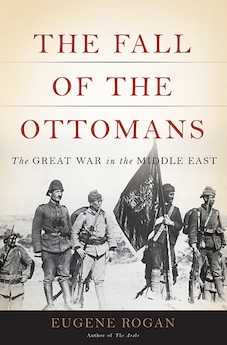By Fred H. Lawson
One hundred years after the outbreak of the First World War, scholarly attention has at last turned to the eastern theater of this unprecedented global conflict. Several notable accounts have recently appeared that deal with the fighting between the Ottoman Empire and Russia along the Caucasus front, British operations in Iraq and the complex strategic and diplomatic dynamics that ended up dragging the Ottomans into the war. No previous study exhibits the comprehensiveness and flair of Eugene Rogan’s The Fall of the Ottomans.
Relying on an impressive collection of archival and local sources, including a wide range of printed and manuscript material in Turkish and Arabic, Rogan weaves together the diverse components of the eastern theater in a cogent and thoroughly riveting narrative. Elegant chapters lay out the threatening foreign and domestic circumstances that Ottoman policy-makers confronted by the momentous summer of 1914, which were only exacerbated as a result of the internal rivalries that shook the Empire in the wake of the 1908 Young Turk revolution. The intricate process whereby the Ottoman Empire decided to align itself with the Triple Alliance rather than the Triple Entente is laid out with particular nuance and insight.
Once the Empire actually joined the fighting—after, as Rogan shows, dragging its feet as long as possible—it found itself embattled on all sides: the Black Sea, the Caucasus, Iraq, Yemen, Egypt, Libya, the Dardanelles. Juggling all of these concurrent campaigns is almost as daunting a challenge for the contemporary historian as it was for Ottoman military commanders. Considerable space is devoted to the better known episodes, most notably Gallipoli, the British Indian advance into Iraq and ensuing disaster at Kut al-Amarna and General Edmund Allenby’s final offensive in Palestine and Syria. But other aspects of the war get covered as well, many of which have tended to be relegated to specialist treatises. Among these are the successive battles between British and Ottoman forces at the southern end of the Red Sea, the struggle for control of Cyrenaica and the contest for al-Salt and ‘Amman in what later became Transjordan.
One hopes that future scholarship on the First World War in the Ottoman domain will fill in the story of these overlooked campaigns in greater detail, although Rogan may well have reached the limits of what we can glean from the surviving sources. Two other topics could be pursued with profit in the next generation of studies as well. Rogan points out that several prominent Ottoman military officers, including Jafar al-Askari, gained valuable experience fighting with the elite Special Organization in Libya, but later joined the Arab revolt against the Empire led by Sharif Husayn bin Ali of Mecca. How and why these officers switched sides remains largely unexplored: Rogan notes that most of these nascent Arab nationalists were captured by the British and transferred to prisoner of war camps; here they were courted by British intelligence officers, and then convinced by the Sharif to join the rebellion, perhaps due to Husayn’s public “declaration of Arab independence.” The wartime processes whereby this profound political and ideological transformation transpired would be worth addressing in a more sustained fashion, if not for any particular individual then for the cohort that these officers represented.
Second, situating the political and military dimensions of the war in the context of ongoing economic and social trends might help to explain significant shifts in the overall direction of strategic operations and the outcome of specific engagements. It seems especially likely that commercial developments played a crucial role in sparking the string of revolts that took place in southern Iraq during the spring of 1915, and in shaping the course of events in Yemen and the environs of Aden. But before such connections can be adequately formulated, a compelling and solidly grounded synthesis of the war’s trajectory across the Middle East is required, and we now have one in hand thanks to Eugene Rogan.
Fred H. Lawson (ΦBK, Indiana University, 1973) is the Lynn T. White, Jr. Professor of Government at Mills College and a resident member of the Zeta of California chapter of Phi Beta Kappa.




